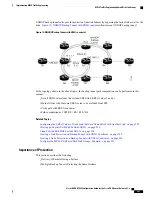
Purpose
Command or Action
Exits the current configuration mode.
exit
Example:
RP/0/RP0/CPU0:router(config-mpls-te)#
exit
Step 5
RP/0/RP0/CPU0:router(config)#
Enters a name for the OSPF process.
router ospf process-name
Example:
RP/0/RP0/CPU0:router(config)#
router ospf 1
Step 6
Configures an area for the OSPF process.
area area-id
Step 7
Example:
RP/0/RP0/CPU0:router(config-router)#
area 0
•
Backbone areas have an area ID of 0.
•
Non-backbone areas have a non-zero area ID.
Exits the current configuration mode.
exit
Example:
RP/0/RP0/CPU0:router(config-ospf-ar)#
exit
Step 8
RP/0/RP0/CPU0:router(config-ospf)#
Sets the MPLS-TE loopback interface.
mpls traffic-eng router-id ip-address
Example:
RP/0/RP0/CPU0:router(config-ospf)#
mpls
Step 9
traffic-eng router-id 192.168.70.1
commit
—
Saves the configuration changes and remains
within the configuration session.
Use the
commit
or
end
command.
Step 10
end
—
Prompts user to take one of these actions:
•
Yes
—
Saves configuration changes and exits the
configuration session.
•
No
—
Exits the configuration session without
committing the configuration changes.
•
Cancel
—
Remains in the configuration session,
without committing the configuration changes.
(Optional)
Verifies the traffic engineering topology.
show mpls traffic-eng topology
Example:
RP/0/RP0/CPU0:router#
show mpls traffic-eng
Step 11
Cisco IOS XR MPLS Configuration Guide for the Cisco CRS Router, Release 5.1.x
215
Implementing MPLS Traffic Engineering
Building MPLS-TE Topology






























